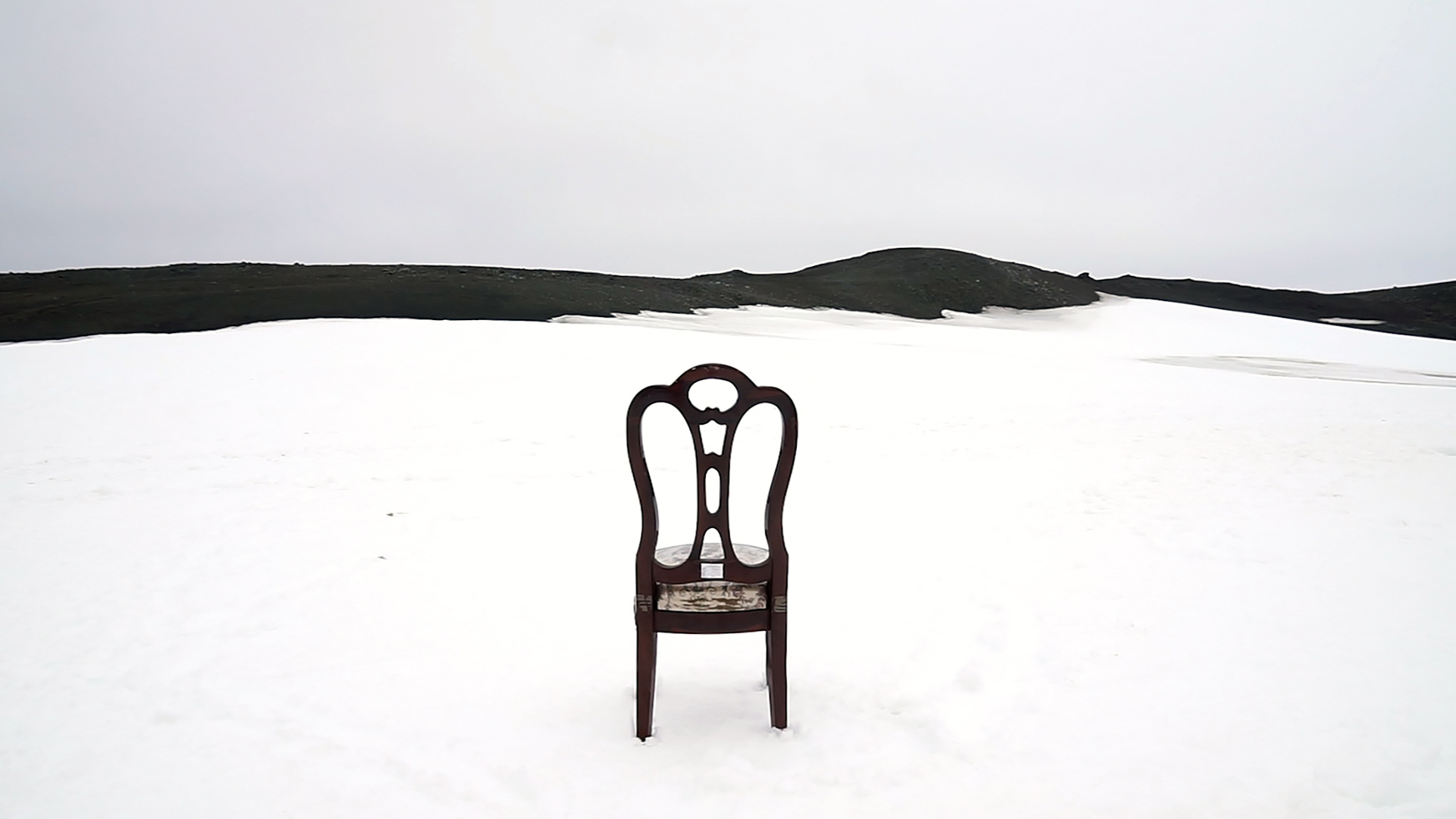Testo di Salvatore Crucitti e Gloria Zeppilli

In this article, we aim to explore the connections of a work that opens new horizons on the staging of an eloquent geography. We discuss the end and how it is possible to render the sensation of extinction tangible. We focus on the performative matter of time and how it acts in the causalities interconnected with the presence and absence of humanity. “Auf den Feldern der Zeit” (In the Fields of Time) by Esteban Sánchez makes the architectures of contemporary thought accessible, condensing a sensory practice into a relational research between art and anthropology.
An absent hero sends instructions, like a commander, to a group of researchers in Antarctica. The mission is to take photos of a wooden chair on the least populated continent on the planet. The spaces chosen for contemplation are the least “Antarctic” places in Antarctica, those that most evoke the evanescence of a geography. The writing of the landscape is permeated by suspension, where everything creaks silently. The green streaks of the Antarctic landscapes have made it possible to bring out primordial documents and materials. A spontaneous and automatic archive, in continuous growth, not by accumulation but by dispersion. This is how objects maintain a relationship with the end, and how Sánchez’s work represents the apex of a mound (from tumere, to be swollen) that rises from a flat base. Just like the flat white layer of the Antarctic horizon becomes an aesthetic matter with a motion similar to breathing.
The work is presented through smartphone screens set into polystyrene panels. From the installation emanates a non-human gurgling sound that emerges from the device, whispering the plunge of Déborah Danowski and Eduardo Viveiros de Castro when they write: “When the world ends, there will be no off-screen voice to comment on the end of the world”. This anguish is synthetically settled in the polystyrene that lines the room, creaking and crumbling as visitors pass. The cracks in the horizon are cell phones that organically occupy the area of the room with cables (similar to arteries) necessary for energy supply. The gaze rests on the vanishing point, which materializes in a solitary fruition of a collective activity, that of the researchers, temporary and nomadic.
A reflection on time, a pillar in Sánchez’s research, and its performativity. The temporal process, when reversed on a concrete plane, is closely linked to a process of global coordination. Alignment is based on atomic clocks scattered around the world, closely connected to the Earth’s rotation. The Earth’s rotation speed is not constant and fluctuates, for this reason, to maintain temporal alignment, semi-annual adjustments are necessary. Since 1972, irregularities in the Earth’s movement have required the addition of 27 leap seconds, but for the first time in recent years, a change has been recorded. Due to the melting of polar ice caps, the Earth has increased its rotation speed, so much so that it is no longer necessary to add, but to remove a leap second. This could cause unprecedented problems and therefore unpredictable risks.
The change induced by humanity not only on the environment but also on measurements and consequently on life rhythms opens up unexpected glimpses for us. In the work, the stasis and absence of the chair in a place like Antarctica tear perspectives that have connections with an art not only of the encounter between artist and performers for the success of an artifice but of an intense weaving of relationships. This aspect ties into one of the most central theoretical debates at this historical moment, regarding the questioning of humanity’s central position. The work opens windows on the possibilities of formalizing anthropocentrism and how it can clash with its opposite. The artist, the performer-researchers, and the visitor intersect their plural visions that inevitably converge into hyperobjects. We can illuminate these ramifications with the words of Timothy Morton when he talks about futurity reinscribed in the present, ending the metaphysics of presence, forcing us to live with a strange future, a future without “us”.




References
- Agnew, D.C.; A global timekeeping problem postponed by global warming. Nature 628, 333–336 (2024).
- Deborah Danowski, Eduardo Viveiros de Castro, “Há mundo por vir? Ensaio sobre os medos e os fins” Editora Cultura e Barbárie, Instituto Socioambiental (ISA).
- Claudia Castellucci, La questione estetica di un archivio artistico, nella concezione e nell’uso. Seminario condotto dalle persone del Laboratorio sull’Archivio della Societas Raffaello Sanzio, diretto da Claudia Castellucci, (2019), Cesena, Teatro Comandini.
- Timothy Morton, Hyperobjects. Univ of Minnesota Pr; 1° edizione (23 settembre 2013)
Images (from the exhibition at Matjö – Raum für Kunst | Kulturwerk des BBK Köln e.V.): Esteban Sánchez, „Auf den Feldern der Zeit“ (detail), mixed-media/audio installation, 2024.
©ESTEBAN SÁNCHEZ/COURTESY OF THE ARTIST
Esteban Sánchez (Bogotá, Colombia 1982)
Transdisciplinary artist – processual art
Esteban Sánchez began his studies and academic interests in art attending Pratt Institute New York, Purchase College (SUNY) and Westchester Community College (SUNY) and completed his graduate studies in 2010 at the Universidad Nacional de Colombia. Thanks to an art scholarship from the German Academic Exchange Service (DAAD), he studied since 2011 as a guest in the postgraduate program at the Academy of Media Arts Cologne (KHM). His academic career is complemented by a master’s degree in philosophy from the Rheinische Friedrich-Wilhelms-Universität Bonn (University of Excellence) in 2021. As an independent artist and experimental researcher, Esteban Sánchez addresses themes that border between the areas of philosophy and art, focusing on reflections on media and their contemporary understanding, drawing as thought, sculpture as landscape, sound as materiality and language as a dichotomy between reality and imagination. His works have been exhibited in renowned museums, institutions and contemporary art galleries in the cities of Bogotá (COL), Cartagena (COL), Medellín (COL), Santa Marta (COL), Havana (CUB), Bilbao (ESP), Bochum (GER), Bonn (GER), Cologne (GER), Frankfurt am Main (GER), Leipzig (GER), Soest (GER), London (GB), Budapest (HUN) and Oporto (POR). Esteban Sánchez currently lives and works in Cologne.

